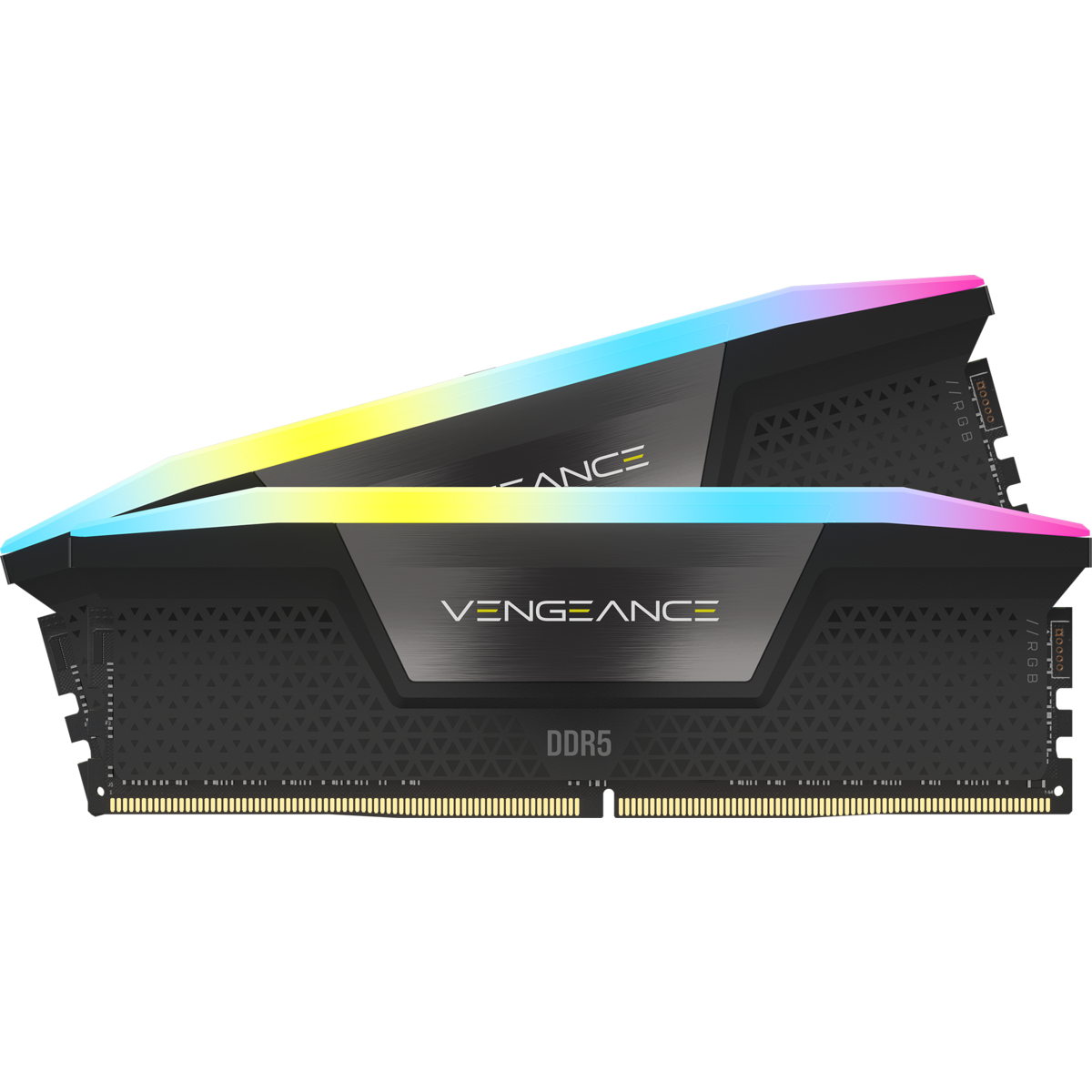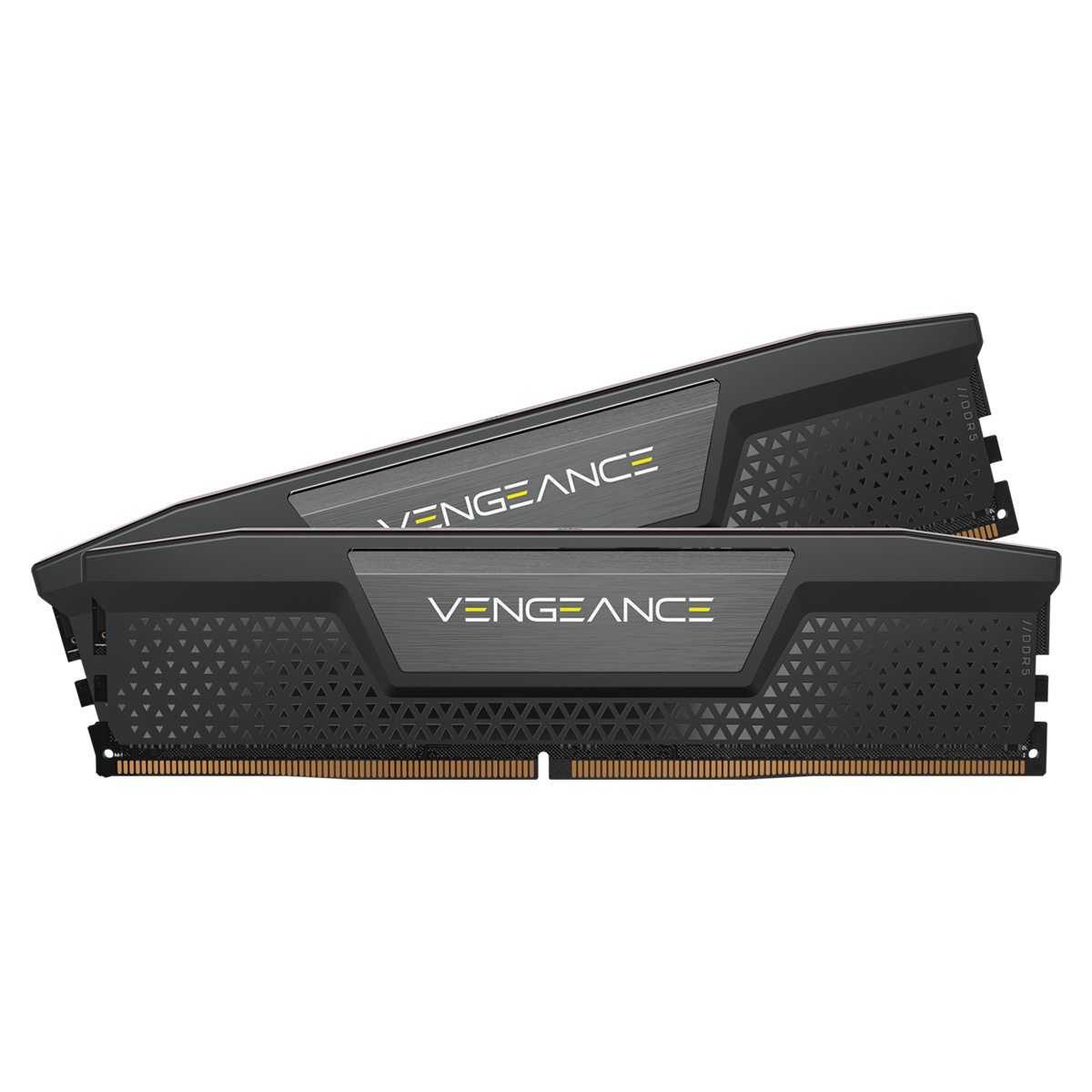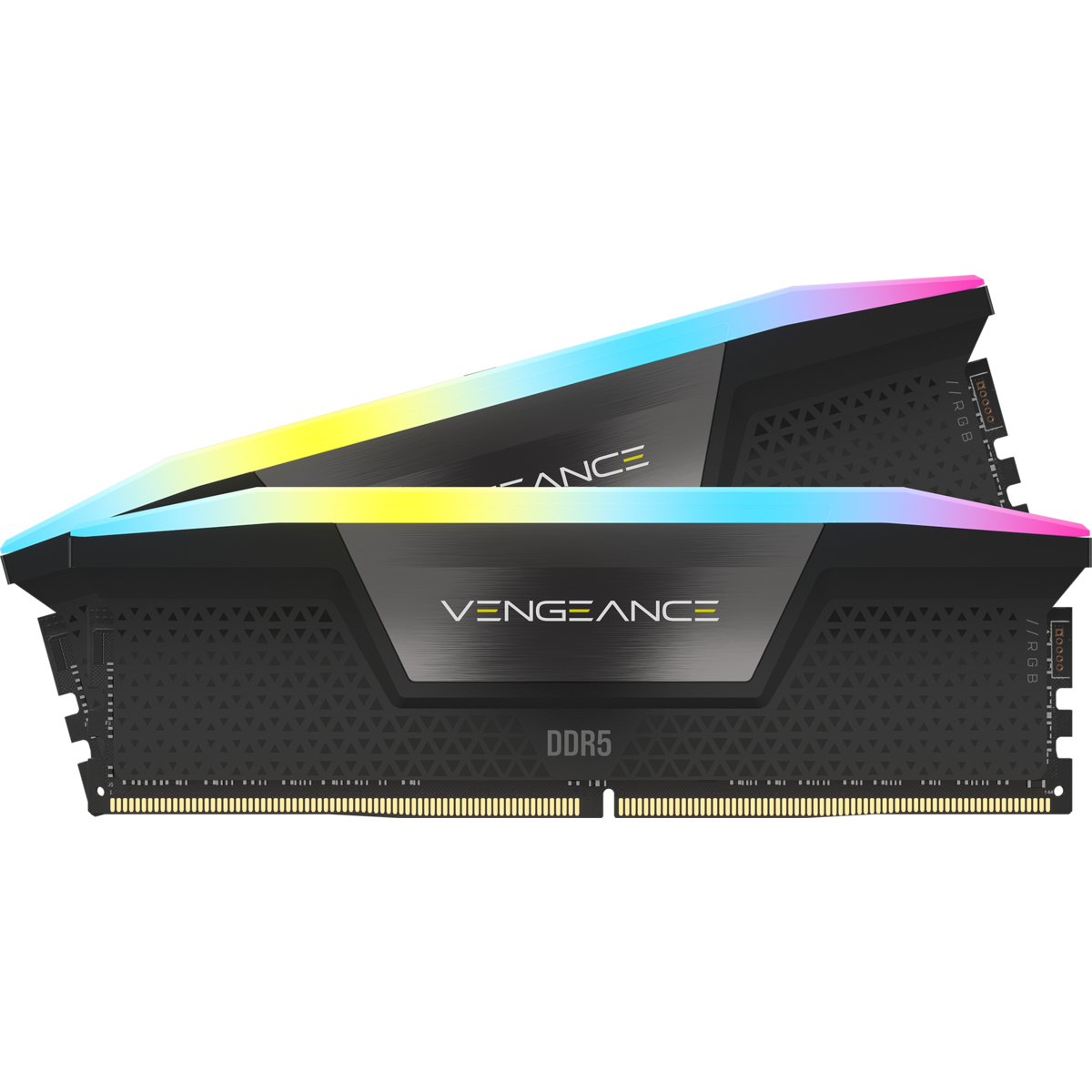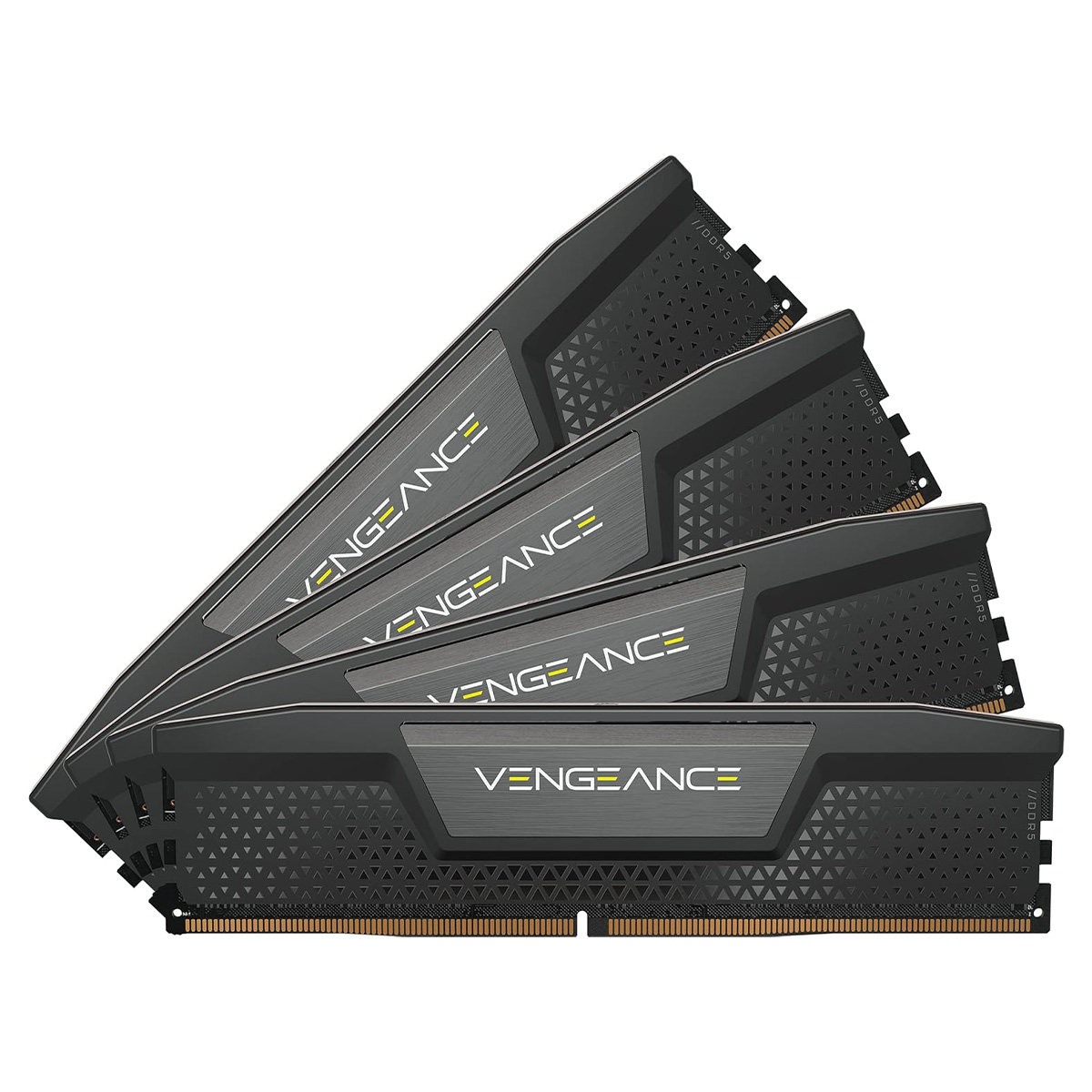DDR5 Memory
The third most important feature when building a gaming pc. To put it simple, the more the better! Faster RAM is also defined by its frequency where higher is better.
When looking for RAM consider the make and model too. Manufacturers often build systems with either unbranded RAM (this translates to cheap far east junk!) or the bottom end range of a brand; Corsair do basic ram designed for basic budget systems and it is just known as Corsair Value RAM, but they also do an LPX Range which is far better. We only use Corsair LPX DDR4 RAM or better here, its regarded the best in the industry and has been for years. They back this up by offering a lifetime warranty with all of their RAM.
It is also worth noting that we use the correct channel configuration - For example if you choose 16GB we would use 2 x 8GB modules so that it operates in dual channel as it should. Many system builders would use a single, and cheaper, 16GB module which means the RAM would only operate single channel mode and whilst it may appear to look good on a spec sheet, it will impact the RAM performance by as much as 35%! All RAM nowadays runs in either Dual or Quad channel meaning it must be configured in equally split module sizes of 2GB, 4GB, 8GB, 32GB, 64GB, 128GB etc, any other configuration is incorrect.
How much RAM will depend on the task in hand - for basic tasks such as browsing, word processing and emails 8GB is enough. Older PC games require 8GB of RAM, whilst the newer, higher end titles will demand 16GB, or in rare cases 32GB, to ensure they run in all their glory. Multimedia editing and workstations will ideally want 32GB upwards. Right now, the price point sweet spot is 16GB and is plentiful for 90% of users however the price of RAM tends to fall over time and is a common upgrade for our customers that wish to futureproof their purchase.
Now you know how much RAM you need, how fast does it need to be? RAM speed is defined by frequency, with current DDR4 Modules they start at 2133Mhz and go all the way to 5333Mhz. The sweet spot for intel based systems is 2400Mhz - 3200Mhz whilst AMD based systems is between 3000Mhz - 3600Mhz, anything north of these numbers offers barely any real world performance increase, so much so we don't even list anything faster than 3600Mhz as its just a waste of money. At the same time we don't list anything below 3000Mhz as the small performance bump between lower speeds and 3000Mhz isn't worth the cost saving. 3000Mhz is the perfect sweet spot for gamers, whilst workstation users and multimedia creators and streamers should look to the faster 3200Mhz and 3600Mhz options.
DDR5 RAM modules start at 4400Mhz all the way up to 7600Mhz. 4800Mhz is the sweet spot and for those looking for that little more 5600Mhz tends to be the ceiling after which the gains are practically non existant.
32GB Corsair Vengeance DDR5 5200MT/s (2 x 16GB)
Push the limits of performance with CORSAIR VENGEANCE DDR5 Memory optimized for Intel®, taking advantage of higher frequencies and greater capacities of DDR5.
| Storage Capacity | 32GB (2 x 16GB) |
|---|---|
| Memory Speed | 5200MT/s |
| Latency Timings | 40-40-40-77 |
| Technology | DDR5 (Dual Channel) |

32GB Corsair Vengeance RGB DDR5 6000MT/s (2 x 16GB)
CORSAIR VENGEANCE RGB DDR5 memory delivers DDR5 performance, higher frequencies, and greater capacities optimized for Intel® motherboards while lighting up your PC with dynamic, individually addressable ten-zone RGB lighting.
| Storage Capacity | 32GB (2 x 16GB) |
|---|---|
| Memory Speed | 6000MT/s |
| Latency Timings | 36-36-36-76 |
| Technology | DDR5 (Dual Channel) |

64GB Corsair Vengeance DDR5 5200MT/s (2 x 32GB)
Push the limits of performance with CORSAIR VENGEANCE DDR5 Memory optimized for Intel®, taking advantage of higher frequencies and greater capacities of DDR5.
| Storage Capacity | 64GB (4 x 16GB) |
|---|---|
| Memory Speed | 5200MT/s |
| Latency Timings | 40-40-40-77 |
| Technology | DDR5 (Dual Channel) |

64GB Corsair Vengeance RGB DDR5 6000MT/s (2 x 32GB)
CORSAIR VENGEANCE RGB DDR5 memory delivers DDR5 performance, higher frequencies, and greater capacities optimised for Intel® motherboards while lighting up your PC with dynamic, individually addressable ten-zone RGB lighting.
| Storage Capacity | 64GB (4 x 16GB) |
|---|---|
| Memory Speed | 6000MT/s |
| Latency Timings | 40-40-40-77 |
| Technology | DDR5 (Dual Channel) |

96GB Corsair Vengeance RGB DDR5 6000MT/s (2 x 48GB)
CORSAIR VENGEANCE RGB DDR5 (CMH96GX5M2B6600C32) memory delivers DDR5 performance, higher frequencies, and greater capacities optimized for Intel® motherboards while lighting up your PC with dynamic, individually addressable ten-zone RGB lighting.
| Storage Capacity | 96GB (2 x 48GB) |
|---|---|
| Memory Speed | 6000MT/s |
| Latency Timings | 32-39-39-76 |
| Technology | DDR5 (Dual Channel) |

96GB Corsair Vengeance RGB DDR5 6400MT/s (4 x 24GB)
CORSAIR VENGEANCE RGB DDR5 (CMH96GX5M4B6400C32) memory delivers DDR5 performance, higher frequencies, and greater capacities optimized for Intel® motherboards while lighting up your PC with dynamic, individually addressable ten-zone RGB lighting.
| Storage Capacity | 96GB (4 x 24GB) |
|---|---|
| Memory Speed | 6400MT/s |
| Latency Timings | 32-40-40-84 |
| Technology | DDR5 (Dual Channel) |

192GB Corsair Vengeance DDR5 5200MT/s (4 x 48GB)
CORSAIR VENGEANCE DDR5 (CMK192GX5M4B5200C38) delivers the higher frequencies and greater capacities of DDR5 technology in a high-quality, compact module that suits your system.
| Storage Capacity | 192GB (4 x 48GB) |
|---|---|
| Memory Speed | 5200MT/s |
| Latency Timings | 38-38-38-84 |
| Technology | DDR5 (Quad Channel) |
